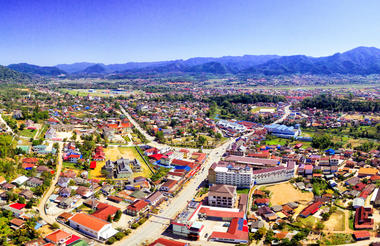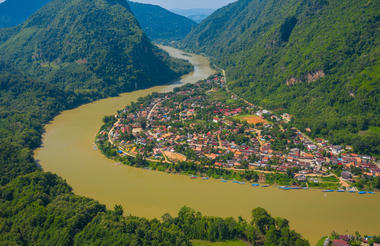Wedged between a number of larger neighbouring countries, Laos is often overlooked in favour of tourism giants such as Thailand and Vietnam. But these travellers are missing out on an extraordinarily scenic and culturally rich destination. Laos boasts a reputation as the least visited, least Westernised, and most untouched of all Indochinese nations. Only time will tell how long this will last, but while it does, visitors who choose to explore this nation’s remote areas will be richly rewarded. Laos’ primary drawcard is undoubtedly the mighty Mekong River which traverses the length of the country and is considered the second most biodiverse river in the world. In the north, the landscape is characterised by little-explored jungle-clad mountainous areas where visitors can witness the intriguing cultures of the various hill tribes that populate this region. Travellers on the hunt for cultural interest should head for the bustling capital of Vientiane, with its innumerable temples and Buddhist monuments. It is this variety of exotic wildlife, remote wilderness and remarkable cultural treasures that make Laos a truly unique and unforgettable holiday destination.
A charming town with elegant historical architecture and a distinctly French flavour, Luang Prabang in northern Laos is filled with interesting museums, bustling markets and traditional shops. 33 Buddhist temples dot the city.; the Haw Kham Royal Palace Museum and Wat Xieng Thong temple give travellers some background on and history of the Laotian people. Beyond the city, breathtaking nature and ancient sites await. Those who visit the Pak Ou Caves can see hundreds of Buddha statues accumulated there through the ages. The 180-foot Kuang Si Waterfalls, an hour’s drive out of the city, is one of the region’s natural highlights, with its layer upon cascading layer of turquoise pools and torrents.



Oudomxay, a naturally beautiful and largely undeveloped province in northwestern Laos, is known for its mist-draped mountains, deep forests and remarkable cultural diversity, with numerous indigenous tribes calling the region home. Its capital, Muang Xay—often referred to simply as Oudomxay—is the main transport hub for northern Laos and an ideal base for travellers eager to explore the surrounding wilderness on foot. Highlights include the province’s many caves and waterfalls, the 600-year-old Phouthat Stupa perched above town, the revered Phachaosingkham Temple, and the tranquil Nam Hin Lake. Visits to traditional villages offer meaningful encounters with local communities and insight into centuries-old customs. For a gentler pace, Muang Xay’s lively night market provides an easygoing evening out, with stalls selling local dishes, drinks, handicrafts and clothing. Rugged, authentic and culturally rich, Oudomxay offers a rewarding glimpse into northern Laos beyond the well-trodden path.



As previously described


Set amid dramatic limestone cliffs along the serene Ou River, Nong Khiaw is a picturesque riverside town that invites travellers to slow down and linger for days. Verdant jungle trails lead to remote hill-tribe villages where traditional dress and time-honoured customs remain part of daily life, while bamboo-raft trips down the river reveal sweeping views of lush mountains and quiet rural scenes. A short, scenic 2-kilometre walk takes visitors to the historic Pha Tok Caves, once a refuge for Pathet Lao soldiers during the Second Indochina War. After a day of exploring, the town’s simple spas offer soothing steam baths and traditional massages—an ideal way to unwind as sunset settles over the cliffs. Rugged, peaceful and visually spectacular, Nong Khiaw is one of northern Laos’s most captivating small-town escapes.



As previously described









